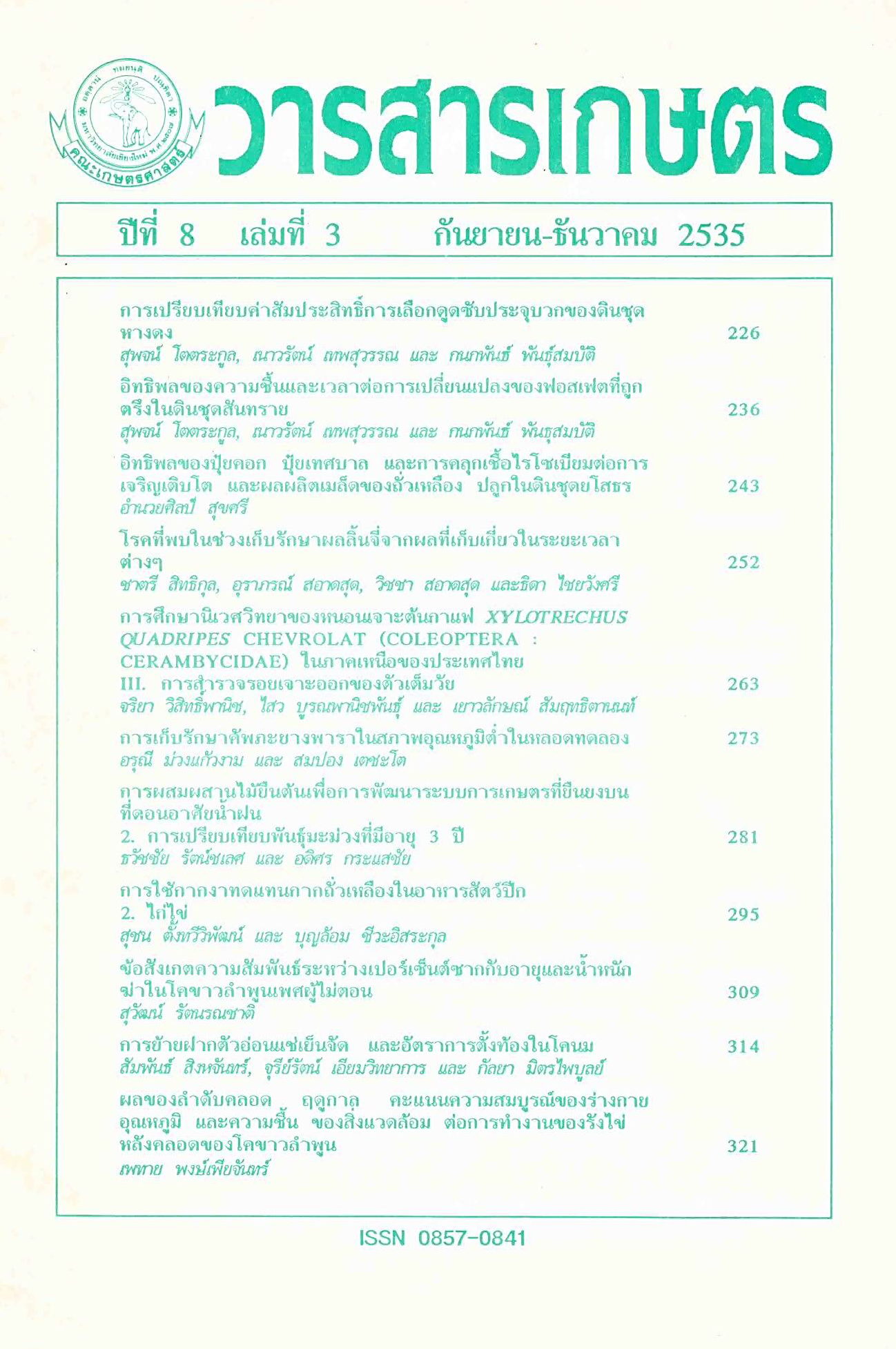การใช้กากงาทดแทนกากถั่วเหลืองในอาหารสัตว์ปีก 2. ไก่ไข่
Main Article Content
บทคัดย่อ
การศึกษาคุณค่าทางอาหารและการใช้กากงาชนิดที่ผลิตเองในท้องถิ่น และชนิดที่นำเข้าจากต่างประเทศเป็นแหล่งโปรตีนทดแทนกากถั่วเหลืองระดับ 0, 25, 50 และ 75% ในอาหารไก่ไข่ ได้ทำการศึกษาในไก่พันธุ์โกเดนฮับบาร์ด จำนวน 336 ตัว เลี้ยงบนกรงตับแบบขังเดี่ยวที่มีน้ำและอาหารกินแบบเต็มที่ตลอดระยะเวลาทดลอง 252 วัน อาหารทุกสูตรได้รับการปรับให้มีโปรตีนเท่ากันคือ 16%.
กากงาชนิดผลิตในท้องถิ่นและชนิดนำเข้า มีโปรตีน 35.7 และ 36.3, ไขมัน 24.7 และ 9.1% air dry basis ตามลำดับ มีกรดอะมิโนที่จำเป็นชนิดไลซีน (Lysine) 0.44 และ 0.94%; เมทไธโอนีน (Methionine) + ซีสตีน (Cystine) 1.06 และ 1.75%; และทรีโอนีน (Threonine) 0.52 และ 1.22% ตามลำดับ ซึ่งต่ำกว่าค่าที่อ้างอิงโดย NRC (1984) เมื่อนำไปใช้ในอาหารไก่ไข่ปรากฏว่า กากงาชนิดที่นำเข้าสามารถใช้ทดแทนกากถั่วเหลืองได้ 50% โดยไม่มีผลเสียต่อผลผลิตไข่ ปริมาณอาหารที่กิน น้ำหนักตัวเพิ่ม น้ำหนักไข่เฉลี่ยและขนาดไข่ในแต่ละเกรด (เบอร์) ในขณะที่กากงาชนิดผลิตในท้องถิ่นไม่ว่าใช้ที่ระดับใด ทำให้ผลผลิตไข่ด้อยกว่ากลุ่มควบคุมอย่างมีนัยสำคัญ (P<0.05) แต่เมื่อเปรียบเทียบระหว่างกากงาทั้งสองชนิด ไม่พบว่ามีสมรรถภาพการผลิตต่างกัน ยกเว้นเมื่อใช้กากงาชนิดผลิตในท้องถิ่นระดับสูงสุด (แทนที่กากถั่วเหลือง 75%) ซึ่งให้ผลด้อยกว่ากลุ่มอื่น ๆ
Article Details
เอกสารอ้างอิง
จันทลักขณา, จรัญ. (2523). สถิติวิธีวิเคราะห์และวางแผนงานวิจัย. สำนักพิมพ์ไทยวัฒนาพานิช จำกัด. กรุงเทพฯ.
ตั้งทวีวิพัฒน์, สุชน. และ ชีวะอิสระกุล, บุญล้อม. (2535). การใช้กากงาทดแทนกากถั่วเหลืองในอาหารสัตว์ปีก. 1 ไก่สาวและนกกระทาไข่. ใน รายงานการประชุมทางวิชาการ สาขาสัตวศาสตร์, หน้า 145-160. มหาวิทยาลัยเกษตรศาสตร์, กรุงเทพฯ.
Aboul, E.S.S., Samy, M.S., Sherif, S.U. and Farid, F.A. (1986). Amino acids of some feed ingredients commonly used in poultry rations. Ann. Agric. Sci. (Cairo) 31(2): 1649-1662.
Abrams, J.T. (1966). Recent Advance in Animal Nutrition. J & A Churchill Ltd. London, UK.
Baghel, R.P.S. and Netke, S.P. (1987). Economic broiler ration based on vegetable proteins. Indian J. Anim. Nutr. 4 (1): 24-27.
Bell, D.E., Ibrahim, A.A., Denton, G.W., Long, G.G. and Bradley, G.L. (1990). An evaluation of sesame seed meal as a possible substitute for soybean oil meal for feeding broilers. Poultry Sci. 69 (Suppl.1): 157.
Brito, OJ. and Nunez, N. (1982). Evaluation of sesame flour as a complementary protein source for combinations with soy and corn flours. J. Food Sci. 47: 457-460.
Canale, A., Turi, R.M. and Valente, M.E. (1975). Apparent digestibility of the animo acids of sunflower and sesame oilmeals by hens. Rivista di Zootecnia e Veterinaria No 4, p 335-343.
Doran, B.H., Krueger, W.F. and Bradley, J.W. (1982). The feasibility of phase feeding sulphur animo acids to egg production stock during the laying period. Poultry Sci. 61(7): 1453.
Gohl, B. (1981). Tropical Feeds. Food and Agriculture Organization of the United Nations. Rome, Italy.
Hassan, O.E.M. (1974). Utilization of tropical feedingstuffs in the nutrition of modern commercial laying stock. Tropical Agri. 51(4): 569-573.
Heo, C.K., Lee, J. Y. and Lee, Y.C. (1990). Feeding value of various plant oil meals as a substitution of soybean meals in broiler diet. Korean J. Anim. Nutr. Feedst. 14(1): 14–19.
Hossain, M.A. and Jauncey, K. (1989). Studies on the protein, energy and amino acid digestibility of fish meal, mustard oilcake, linseed and sesame meal for common carp (Cyprinus carpio L.). Aquaculture 83 (1-2): 59-72.
Lease, J.G. (1972). Effect of histidine in tibia alkaline phosphatase of chicks fed zinc-deficient sesame meal diets. J. Nutr. 102(10): 1323-1330
Lease, J.G. and Williams, W.P. Jr. (1967). Availability of zinc and comparison of in vitro and in vivo zinc uptake of certain oil seed meals. Poultry Sci. 46: 233–241.
Lennerts. L. (1989). Sesame cakelexpeller and sesame oilmeal. Muhle + Mischfuttertechnik 126(17): 240-241.
NRC (National Research Council). (1984). Nutrient Requirements of Poultry, 8th Ed. National Academy Press. Washington, D.C., USA.
Spindler, M., Stadler, R. and Tanner, H. (1984). Amino acid analysis of feedstuffs: Determination of methionine and cystine after oxidation with performic acid and hydrolysis. J. Agric. Food Chem. 32: 1366-1371.
Yamazaki, M. and Kamata, H. (1986). Amino acid availability of feed ingredients for poultry. Japanese Poultry Sci. 23(3): 147-156.


